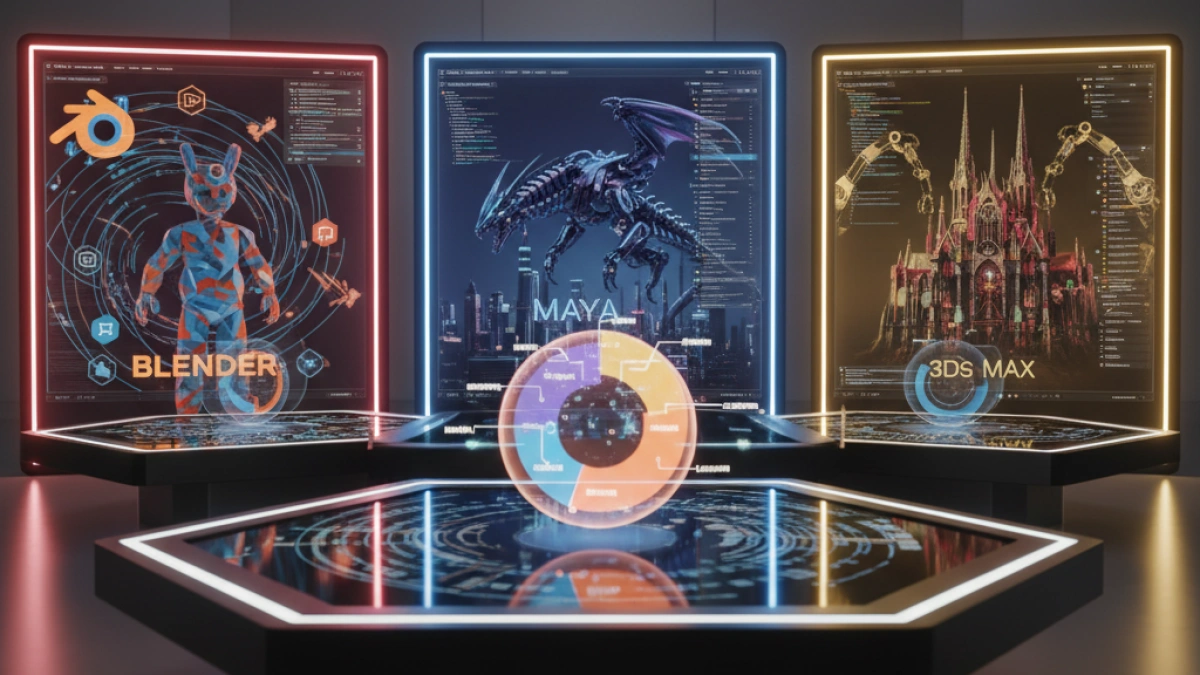Comparative Analysis of 3D Software Blender vs Maya vs 3ds Max


3D modeling and animation have revolutionized the entertainment, design, architecture, and many other fields. In this article, we will conduct a comparative analysis of three of the most popular programs for creating 3D content: Blender, Maya, and 3ds Max. As we delve into their features, advantages, and disadvantages, you will be able to make informed decisions about which software best fits your needs.
Introduction
Choosing the right 3D software is crucial for artists, designers, and developers. Each of these programs has unique features that can influence the quality and efficiency of the work produced. This analysis will cover the following aspects:
- User interface
- Functionality
- Performance
- Community and support
- Pricing
User Interface
Blender
Blender has a flexible interface, although it can be overwhelming for beginners. Customization is one of its strong points, allowing users to adapt the workspace to their needs. However, the learning curve can be steep.
Maya
Maya offers a more intuitive and organized interface, making it ideal for new users. Its design is professional and provides specific tools that facilitate work in various areas such as modeling, rigging, and animation.
3ds Max
3ds Max has an interface that is similar to Maya, focusing on accessibility. It is known for its ease of use, especially for Windows users. The layout of the tools is clear, allowing for a smooth experience.
Functionality
Blender
Blender is open-source software that provides an impressive variety of tools. Some noteworthy functionalities include:
- Modeling: Sculpting tools, retopology, and parametric modeling.
- Animation: Advanced tools for rigging and animation.
- Rendering: Cycles and Eevee rendering engines, which are highly efficient.
- Simulation: Support for fluid, particle, and physics simulations.
Maya
Maya is known for its robust set of animation and visual effects tools. Some of its most notable functionalities include:
Read also
- Modeling: Polygonal modeling and NURBS tools.
- Rigging: Advanced rigging system for creating skeletons and controllers.
- Animation: Tools for motion capture and curve-based animation.
- Simulation: Particle and hair simulation solutions.
3ds Max
3ds Max is popular in the architectural visualization and product modeling industry. Its main functionalities include:
- Modeling: Spline and polygon modeling tools.
- Animation: Keyframe animation system and motion capture options.
- Rendering: Integration with external rendering engines like Arnold and V-Ray.
- Visualization: Specific features for architectural visualization.
Performance
Blender
Blender has significantly improved its performance in recent versions. Its Eevee rendering engine provides real-time results, making visualization easier during the workflow. However, it may be more demanding on hardware for large projects.
Maya
Maya is known for its optimized performance for intensive tasks such as animation and rigging. Its capability to handle large scenes and complex simulations makes it ideal for large-scale productions.
3ds Max
3ds Max is also optimized for visualization and simulation, offering solid performance. Its integration with external rendering engines, such as V-Ray, allows users to achieve impressive visual results without compromising performance.
Community and Support
Blender
Being open-source software, Blender has a vibrant and very active community. There are numerous tutorials, forums, and online resources that users can utilize. However, formal technical support may be limited.
Maya
Maya, being a product of Autodesk, offers professional technical support and a wide range of resources. There is also a strong user community sharing knowledge and tutorials. Its user base is extensive, making it easy to find answers to specific issues.
3ds Max
Like Maya, 3ds Max has technical support from Autodesk and an active community. There are abundant tutorials and resources available, making it easier to learn and troubleshoot issues. Its popularity in architectural visualization has led to a large number of resources focused on that field.
Pricing
Blender
Blender is completely free and open-source, making it a highly attractive option for beginners and independent artists. The absence of licensing costs allows users to experiment without financial concerns.
Maya
Maya is a paid software with monthly and annual licensing options. While it can be costly, many consider the investment worthwhile due to its professional toolset and the support it provides.
3ds Max
Similar to Maya, 3ds Max requires a considerable investment. Autodesk offers monthly and annual licenses, and there are also discounts for students and educators. The value for money is high, especially for professionals in visualization and design fields.
Conclusion
In the comparative analysis of Blender, Maya, and 3ds Max, each software presents its advantages and disadvantages depending on user needs. Blender is ideal for those looking for a free and highly customizable option, while Maya and 3ds Max excel in professional environments, especially for animation and visualization.
Ultimately, the choice of software will depend on factors such as budget, specific project requirements, and technical expertise. Regardless of choice, each of these programs offers powerful tools to bring your ideas into the 3D world.



















